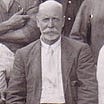The Weir Bridge of 1926
The weir bridge is not the first bridge to cross the river near the pumping station.
The weir bridge is not the first bridge nor even the first weir to cross the river near the pumping station, but it does represent the eventual solution to a couple of problems that plagued the Board after they established a water supply pumping station at Mount Crosby in 1890, namely:
• the river, which was required to provide the water for Brisbane, often ran dry and at other times ran high; and
• the coal fired pumping station was on the opposite side of the river to the coal it needed (and all the other goods and services of Ipswich).
The father of the Mount Crosby water supply scheme, Alexander Stewart, knew that a weir would be required eventually and when making his case in favour of Mount Crosby said, "...its chief advantage lies in the existence of a rock bar a short distance below the proposed intake. This will form an admirable foundation for a weir, which can be built when increased demand renders it necessary...".
Alex was describing the rocky bar about 100 metres downstream from the pumping station, and it was not on that bar, but one a few hundred metres further away that the Board built its first weir in 1902. Not that it was a great success - the poor little thing that stretched halfway across the river valley, hoping, in vain as it turned out, that water would not bypass it to the west. The Board summed it up for themselves when (in 1906) they wrote it had "become useless and was therefore valueless", which is a bit harsh because I spent many afternoons in shorts swimming, fishing and walking near it. I enjoyed, above all, the sound of its soothing and cool cascade.

A weir was certainly needed and so was a decent bridge that couldn't be washed away. The Board had lost two bridges and was well into the third when their Engineer for Water Supply, John Peart, proposed a "new" weir of solid concrete incorporating an overbridge higher than the average flood.
At a cost of £52,000 it seemed expensive at the time, but evidently it was money well spent. The weir is now 97 years old and, aside from a small hiccup in 1927, it has withstood two great floods and a multitude of minor ones.
Who could forget how the waters of 2011 bent downstream as they receded, fooling us into thinking it had failed, and how our faith was restored as the boiling floodwaters took their usual shape and before us stood John Peart’s weir; washed, but not washed away.




